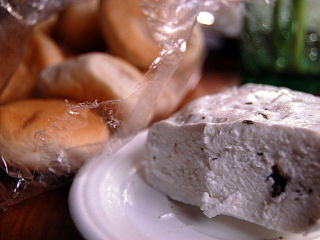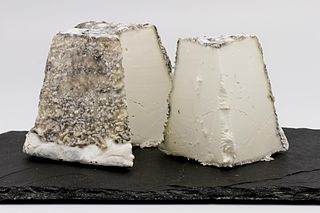
Turkish cuisine is largely the heritage of Ottoman cuisine, which can be described as a fusion and refinement of Mediterranean, Balkan, Middle Eastern, Central Asian, Eastern European and Armenian cuisines. Turkish cuisine has in turn influenced those and other neighbouring cuisines, including those of Southeast Europe (Balkans), Central Europe, and Western Europe. The Ottomans fused various culinary traditions of their realm with influences from Levantine cuisines, Egyptian cuisine, Greek cuisine, Balkan cuisine, along with traditional Turkic elements from Central Asia, creating a vast array of specialities.

Cooking bananas are banana cultivars in the genus Musa whose fruits are generally used in cooking. They may be eaten ripe or unripe and are generally starchy. Many cooking bananas are referred to as plantains or green bananas, although not all of them are true plantains. Bananas are treated as a starchy fruit with a relatively neutral flavour and soft texture when cooked. Bananas fruit all year round, making them a reliable all-season staple food.

Tapioca is a starch extracted from the storage roots of the cassava plant, a species native to the north region central-west region of Brazil, and certain parts of West Africa but whose use is now spread throughout South America. The plant was brought by the Portuguese to much of West Indies, Africa and Asia. It is a perennial shrub adapted to the hot conditions of tropical lowlands. Cassava copes better with poor soils than many other food plants.

Breakfast is the first meal of the day eaten after waking up, usually in the morning. The word in English refers to breaking the fasting period of the previous night. There is a strong likelihood for one or more "typical", or "traditional", breakfast menus to exist in most places, but their composition varies widely from place to place, and has varied over time, so that globally a very wide range of preparations and ingredients are now associated with breakfast.

A pie is a baked dish which is usually made of a pastry dough casing that contains a filling of various sweet or savoury ingredients. Sweet pies may be filled with fruit, nuts, brown sugar or sweetened vegetables. Savoury pies may be filled with meat, eggs and cheese (quiche) or a mixture of meat and vegetables.

Hungarian or Magyar cuisine is the cuisine characteristic of the nation of Hungary and its primary ethnic group, the Magyars. Traditional Hungarian dishes are primarily based on meats, seasonal vegetables, fruits, bread, dairy products and cheeses.

Smoked salmon is a preparation of salmon, typically a fillet that has been cured and hot or cold smoked. Due to its moderately high price, smoked salmon is considered a delicacy. Although the term lox is sometimes applied to smoked salmon, they are different products.

Scrambled eggs is a dish made from eggs stirred, whipped or beaten together while being gently heated, typically with salt, butter and sometimes other ingredients.

Dutch cuisine is formed from the cooking traditions and practices of the Netherlands. The country's cuisine is shaped by its location in the fertile North Sea river delta of the European Plain, giving rise to fishing, farming, and trading over sea, its former colonial empire and the spice trade.

Corn on the cob is a culinary term used for a cooked ear of freshly picked maize from a cultivar of sweet corn. Sweet corn is the most common variety of maize eaten directly off the cob. The ear is picked while the endosperm is in the "milk stage" so that the kernels are still tender. Ears of corn are steamed or boiled, usually without their green husks, or roasted with them. The husk leaves are in any case removed before serving.

Cachapa or Arepa de Chócolo is a traditional dish made from maize flour from Venezuelan and Colombian cuisine. Like arepas, they are popular at roadside stands. They can be made like pancakes of fresh corn dough, or wrapped in dry corn leaves and boiled. The most common varieties are made with fresh ground corn mixed into a thick batter and cooked on a budare, like pancakes; the cachapa is slightly thicker and lumpier because of the pieces from corn kernels.

Bush tucker, also called Bush Food, is any food native to Australia and used as sustenance by Indigenous Australians, the Aboriginal and Torres Strait Islander peoples, but it can also describe any native fauna or flora used for culinary or medicinal purposes, regardless of the continent or culture. Animal native foods include kangaroo, emu, witchetty grubs and crocodile, and plant foods include fruits such as quandong, kutjera, spices such as lemon myrtle and vegetables such as warrigal greens and various native yams.

Kulcha is a type of mildly leavened flatbread that originated in the Indian subcontinent.

Israeli cuisine comprises both local dishes, adopted Arab dishes, and dishes brought to Israel by Jews from the Diaspora. Since before the establishment of the State of Israel in 1948, and particularly since the late 1970s, an Israeli Jewish fusion cuisine has developed.

Cheese is a dairy product, derived from milk and produced in wide ranges of flavors, textures and forms by coagulation of the milk protein casein. It comprises proteins and fat from milk, usually the milk of cows, buffalo, goats, or sheep. During production, the milk is usually acidified and the enzymes of rennet are added to cause the milk proteins (casein) to coagulate. The solids (curd) are separated from the liquid (whey) and pressed into final form. Some cheeses have aromatic molds on the rind, the outer layer, or throughout. Most cheeses melt at cooking temperature.

Kesong puti is a Filipino soft, unaged, white cheese made from unskimmed carabao milk and salt curdled with vinegar, citrus juices, or sometimes rennet. It can also be made with goat or cow milk. It has a mild salty and tart flavor. When an acidifying agent is used, it resembles queso blanco or paneer. When rennet is used, it resembles buffalo mozzarella. Moisture content can also vary, ranging from almost gelatinous to pressed and firm. It can be eaten as is, paired with bread, or used in various dishes in Filipino cuisine. It is usually sold wrapped in banana leaves.

Types of cheese are grouped or classified according to criteria such as length of fermentation, texture, methods of production, fat content, animal milk, and country or region of origin. The method most commonly and traditionally used is based on moisture content, which is then further narrowed down by fat content and curing or ripening methods. The criteria may either be used singly or in combination, with no single method being universally used.
A great variety of cassava-based dishes are consumed in the regions where cassava is cultivated, and they include many national or ethnic specialities.
Ancient Israelite cuisine refers to the food eaten by the ancient Israelites during a period of over a thousand years, from the beginning of the Israelite presence in the Land of Israel at the beginning of the Iron Age until the Roman period. The dietary staples were bread, wine and olive oil, but also included legumes, fruits and vegetables, dairy products, fish and meat. Religious beliefs, which prohibited the consumption of certain foods, shaped the Israelite diet. There was considerable continuity in the main components of the diet over time, despite the introduction of new foodstuffs at various stages. The food of ancient Israel was similar to that of other ancient Mediterranean diets.

Kabanos, also known as cabanossi or kabana, is a long, thin, dry sausage usually made of pork which originated in Poland. They are smoky in flavor, and can be soft or very dry in texture depending on freshness. Typically, they are quite long, 60 cm (24 in), but very thin, with a diameter around 1 cm (0.39 in), and folded in two, giving them a characteristic appearance. Versions made of chicken and turkey are staples in kosher meat markets and delicatessens.

















